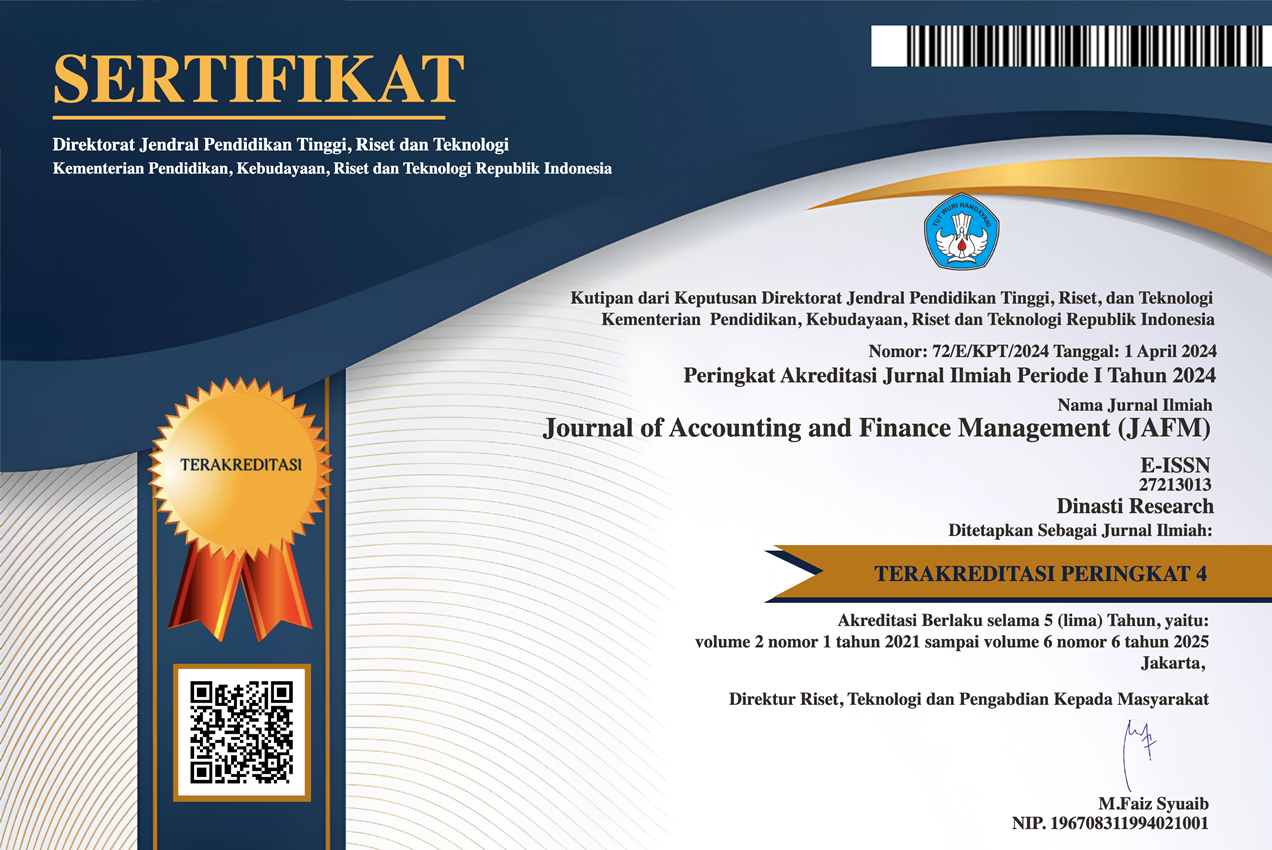Analisis Hubungan Politik Utang Indonesia dan China Untuk Menghindari Debt Trap Diplomacy
DOI:
https://doi.org/10.38035/jafm.v5i4.785Keywords:
Indonesia, China, Debt Trap Diplomacy, Foreign Policy, DependencyAbstract
The analysis of the political relationship of Indonesia's debt to China to avoid debt trap diplomacy discusses the political debt relationship between Indonesia and China, particularly considering the intensive cooperation and debt assistance that China has provided to Indonesia, as well as the establishment of loan condition regulations that threaten the use of the state budget as a payment tool. This writing aims to understand the development of Indonesia's debt to China, whether Indonesia is trapped in a Debt Trap, and how Indonesia can avoid Debt Trap Diplomacy. This research employs a qualitative descriptive analysis method, utilizing previously published sources with data collection sourced from books, journals, and other online media such as websites, databases, and information available on the internet. Based on dependency theory, it shows that loan conditions with high interest rates and strict repayment terms reflect unfavorable lending conditions. The increase in debt to China for the Indonesian economy can stimulate the country's growth, but a significant economic dependence can also make Indonesia more vulnerable to Debt Trap Diplomacy. The research results indicate that based on the analysis of Indonesia's debt to China, there has been a tendency for an increase over the past five years. Indonesia is also still in a position of safe debt ratios, both by national and global standards, and does not fall into the category of Debt Trap Diplomacy. Several steps, approaches, and diplomatic efforts have also been undertaken by Indonesia to avoid Debt Trap Diplomacy.
References
Al-Fadhat, Faris, and Hari Prasetio. 2022. “Debt-Trap Diplomacy: Bagaimana Ekspansi Kapital China Membentuk Jebakan Utang Bagi Negara-Negara Afrika.” Jurnal Ilmiah Hubungan Internasional 18(2): 150–76. doi:10.26593/jihi.v18i2.5262.150-176.
Alden, Chris. 2020. “Understanding Debt and Diplomacy.” : 1–14. https://eprints.lse.ac.uk/110974/1/WorkingPaper01_FIN_04indd.pdf.
Arbar, Thea Fathanah. 2022. “5 Negara Disebut Kena ‘Jebakan Batman’ Utang China, Ada RI?” www.cnbcindonesia.com: 1–4. https://www.cnbcindonesia.com/news/20220420063224-4-333013/5-negara-disebut-kena-jebakan-batman-utang-china-ada-ri.
Badan Pusat Statistik. 2023. No. 34/05/ Www.Bps.Go.Id Pertumbuhan Ekonomi Indonesia Triwulan I-2023. https://www.bps.go.id/pressrelease/2023/05/05/1998/ekonomi-indonesia-triwulan-i-2023-tumbuh-5-03-persen--y-on-y-.html.
BBC News Indonesia. 2023. “Bunga Utang Kereta Cepat Jakarta-Bandung 3,4%, Jebakan Utang China?” https://www.bbc.com/: 1. https://www.bbc.com/indonesia/articles/c72vg2v5732o.
Caner, Mehmet, dkk. 2010. “Finding the Tipping Point—When Sovereign Debt Turns Bad.” Latin America and the Carribean Region. https://documents1.worldbank.org/curated/ru/509771468337915456/pdf/WPS5391.pdf.
Carmody, Pádraig. 2020. “Dependence Not Debt-Trap Diplomacy.” Area Development and Policy 5(1): 23–31. doi:10.1080/23792949.2019.1702471.
Damayanti, Aulia. 2021. “3 Fakta Uganda Gagal Bayar Utang Ke China Berujung Kehilangan Bandara.” https://finance.detik.com/. https://finance.detik.com/berita-ekonomi-bisnis/d-5832520/3-fakta-uganda-gagal-bayar-utang-ke-china-berujung-kehilangan-bandara.
Dikarma, Kamran. 2023. “Wow, Indonesia Jadi Negara Terbesar Terima Investasi Pembangunan Dari China.” https://ekonomi.republika.co.id/. https://ekonomi.republika.co.id/berita/rvr6zn457/wow-indonesia-jadi-negara-terbesar-terima-investasi-pembangunan-dari-china.
Fauziyyah, Putri Zahra, and Arie Kusuma Paksi. 2023. “Dampak Kerja Sama Indonesia-China Dalam Proyek Investasi Nikel Terhadap Pertumbuhan Ekonomi Kedua Negara.” Jurnal Ilmiah Dinamika Sosial 7(1): 86–105. doi:10.38043/jids.v7i1.4279.
Al Ghifari. 2024. “Debt Trap: Bahaya Tipu Daya China Bagi Kedaulatan Indonesia Di Laut China Selatan.” https://www.kompasiana.com/. https://www.kompasiana.com/alghifari2670/6649ee0514709344882c7e12/debt-trap-bahaya-tipu-daya-china-bagi-kedaulatan-indonesia-di-laut-china-selatan.
Hao, Yichen. 2022. “Is China’s Investment A Debt Trap? -A Comparative Research Based on the Investment in the United States, Europe and China.” Proceedings of the 2021 3rd International Conference on Economic Management and Cultural Industry (ICEMCI 2021) 203(Icemci): 2604–10. doi:10.2991/assehr.k.211209.424.
Himmer, Michal, and Zden?k Rod. 2022. “Chinese Debt Trap Diplomacy: Reality or Myth?” Journal of the Indian Ocean Region 18(3): 250–72. doi:10.1080/19480881.2023.2195280.
Idris, Muhammad. 2023. “Biaya Kereta Cepat Jakarta-Bandung Setara Bangun 1.081 Km Tol Di Sumatera.” Kompas.com: 1. https://money.kompas.com/read/2023/04/13/105140026/biaya-kereta-cepat-jakarta-bandung-setara-bangun-1081-km-tol-di-sumatera?page=all.
Kenepri, Geubrina Reuseuki. 2023. “STRATEGI DEBT TRAP TIONGKOK TERHADAP SRI LANKA DALAM MEMBANGUN HEGEMONI DI ASIA.” https://jurnal.univrab.ac.id/ Vol 6 No 1: 1–17. https://jurnal.univrab.ac.id/index.php/is/article/view/4008.
Pemerintah RI. 2003. “UNDANG-UNDANG REPUBLIK INDONESIA NOMOR 17 TAHUN 2003.” (1): 1–40.
Sari, Haryanti Puspadan. Pratama Akhdi Martin. 2022. “5 Penyebab Biaya Proyek Kereta Cepat Jakarta-Bandung Bengkak.” https://money.kompas.com/. https://money.kompas.com/read/2022/07/31/130500126/5-penyebab-biaya-proyek-kereta-cepat-jakarta-bandung-bengkak?page=all.
“Strategi Pemerintah Kelola Utang Negara.” 2012. https://www.djkn.kemenkeu.go.id/berita_media/baca/2601/Strategi-Pemerintah-Kelola-Utang-Negara.html.
Wibisono, Adhe Nuansa. 2019. “China’s ‘Belt and Road Initiative’ in Sri Lanka?: Debt Diplomacy in Hambantota Port Investment.” Jurnal Mandala Jurnal Ilmu Hubungan Internasional 2(2): 222–45. doi:10.33822/mjihi.v2i2.1482.
Downloads
Published
How to Cite
Issue
Section
License
Copyright (c) 2024 Zhafarina Jauza Az Zahro, Faris Al-Fadhat, Andy Prasetiawan Hamzah

This work is licensed under a Creative Commons Attribution 4.0 International License.
Authors who publish their manuscripts in this journal agree to the following conditions:
- The copyright on each article belongs to the author(s).
- The author acknowledges that the Journal of Accounting and Finance Management (JAFM) has the right to be the first to publish with a Creative Commons Attribution 4.0 International license (Attribution 4.0 International (CC BY 4.0).
- Authors can submit articles separately, arrange for the non-exclusive distribution of manuscripts that have been published in this journal into other versions (e.g., sent to the author's institutional repository, publication into books, etc.), by acknowledging that the manuscript has been published for the first time in the Journal of Accounting and Finance Management (JAFM).



























